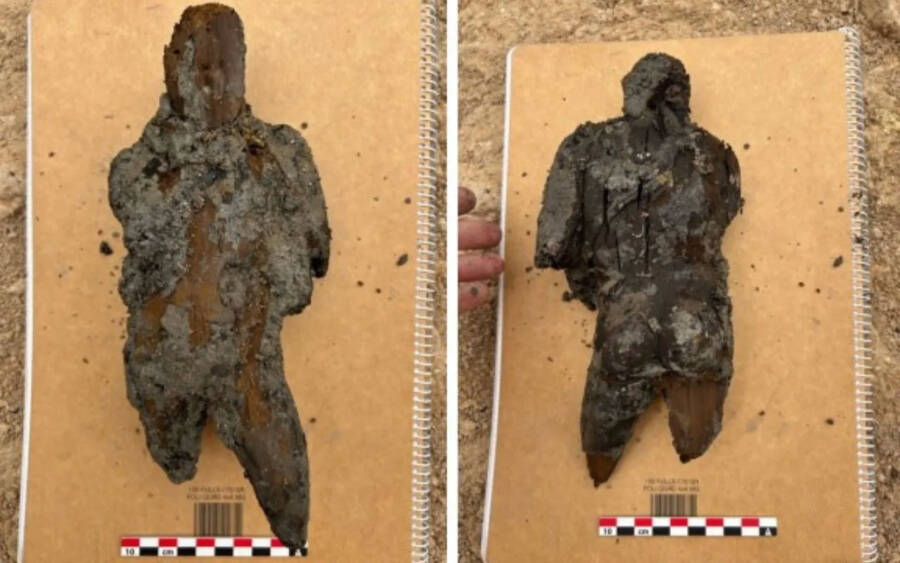2,000-Year-Old Hercules Sculpture Found In An Ancient Roman Refuse Pit On The Spanish Island Of Ibiza
Diario de IbizaThe 2,000-year-old Hercules figurine found on the Spanish island of Ibiza.During preparation for construction of a new housing project in Ibiza, Spain, archaeologists oversaw a controlled drainage of the land. As they sifted through soggy layers, they were surprised to find some truly astonishing ancient artifacts including a 2,000-year-old wooden figurine that appears to be a carving of the famous mythological hero Hercules.Not only is it incredibly rare to find wooden artifacts like this, but this small figurine also provides a fascinating look into Ibizas ancient past some two millennia ago, when it was a Roman city known as Ebusus.The Ancient Hercules Figurine Found In A Roman Refuse Pit In IbizaAccording to the Greek Reporter, the ancient Hercules figurine was discovered during a preventative archaeology excavation ahead of the construction of a new public housing project. Because of the areas deep water table, archaeologists oversaw drainage of the area, which revealed several layers of artifacts ranging from the 18th century to Roman times.The most thrilling artifact was a small, 2,000-year-old figurine, which archaeologists say is a depiction of the mythological figure Hercules.Diario de IbizaA closer look at the 2,000-year-old wooden Hercules figurine that was discovered in Ibiza.Wood never preserves well in Ibiza, unlike in Egypt, which has such a dry climate, said archaeologist Juan Jos Mar Casanova, the co-director of the excavation project. Here, wood and organic materials always rot. But in this case, the water protected it, it didnt destroy it.But how exactly did this figurine survive? Archaeologists found it in an ancient grain silo, which had been repurposed as a garbage dump long ago. Over time, the water table flooded the pit and created the perfect conditions to preserve wooden artifacts. According to Casanova, the natural sealing-off of the pit created an oxygen-free environment that protected the figurine as well as other relics like leather and fruit pits from destructive microorganisms.Its completely unusual, Casanova said, noting that the pit was like a capsule sealed by water and mud that had worked to protect the artifacts from deterioration over the past 2,000 years.Because of this incredible preservation, this new find provides a rare and exciting look back at Ibizas ancient history, when it was a Roman city called Ebusus.The Roles Of Both Ebusus And Hercules In The Ancient MediterraneanIbizas history stretches back at least 3,000 years, when Bronze Age people settled on the island. It became more important in the ancient world in the mid-7th century B.C.E., when the Phoenicians (and later the Carthaginians) used the island as a trading outpost. They worshipped a number of pagan gods, including the terrifying Moloch. But things changed in the 2nd century C.E., when Carthage fell, and Romes power in the region increased.The Portable Antiquities Scheme/The Trustees of the British MuseumA Phoenician coin from Ebusus, the ancient Roman name for whats now Ibiza.The Romans renamed the island Ebusus, which then flourished as a diverse port city. Though the Romans allowed the islanders to maintain many of their Carthaginian traditions and institutions, Greco-Roman culture also permeated daily life, as evidenced by the Hercules figurine.Hercules (known in Greek myth as Heracles or Herakles) was one of the most famous figures of ancient mythology. Legends say that he killed his wife and children after being driven insane by the goddess Hera. Then, in order to atone for his sins, Hercules set out to complete 12 Labors. He kills the Nemean lion, slays a Hydra, captures the Cretan Bull, and steals Cerberus, the dog of the Underworld, among other tasks.Wikimedia CommonsA 16th-century illustration of Hercules, famed hero of ancient Greek and Roman myth.As such, his likeness was used widely throughout the ancient world and has been found frequently by archaeologists over the years, including recently. In 2023, for instance, archaeologists found what appeared to be a statue of Hercules in a Roman sewer, and this year, archaeologists working outside of Florence uncovered a tiny, 20-inch tall figure of the Greco-Roman hero.The Hercules figure found in Ibiza thus belongs to a much larger ancient tradition. But it still stands as an astonishing discovery. By a lucky quirk of nature, this wooden figurine survived 2,000 years. And thanks to the construction of public housing, it has now been rescued from the muck.After reading about the 2,000-year-old Hercules figurine discovered in Ibiza, learn about Tyrian purple, the valuable dye coveted by elites throughout antiquity. Then, discover the chilling and fascinating story of the Roman catacombs that snake beneath the ancient city.The post 2,000-Year-Old Hercules Sculpture Found In An Ancient Roman Refuse Pit On The Spanish Island Of Ibiza appeared first on All That's Interesting.


